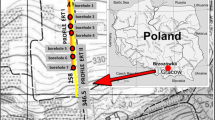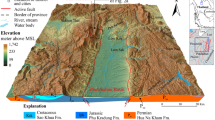Abstract
The aim of this study was to convert a resistivity field into a local factor of safety (LFS) field in order to capture the characteristics of the water infiltration and slope failure processes in loess landslides. The generalized earth pressure coefficient and the LFS were introduced, and a method based on the monitoring of the resistivity field was proposed. An improved electrical resistivity tomography (ERT) method was then adopted. The water infiltration and the distribution of water inside the slope were analyzed using the slope sequence resistivity field for two rainfall scenarios. The validity and the physical justification of the proposed method were then verified. The results were as follows: (i) the proposed method could effectively capture the failure location and the instability process of the slope. (ii) Although the proposed method ignored the heterogeneity of the slope body, when the migration process and the distribution characteristics of the water within the slope under two rainfall scenarios were clearly presented, the conversion from the slope resistivity field to the soil moisture content (SMC) field was theoretically feasible. (iii) The uniform infiltration pattern induced the shallow landslides or mudflows with long-term light rainfall. Middle and deep loess landslides were easily induced by the significant preferential infiltration phenomenon with short-term heavy rainfall. The proposed method is very important for the early identification and risk mitigation of water-inducing landslides in loess areas, and it is helpful for developing a deeper understanding of the preferential flow within soil.













Similar content being viewed by others
References
Bishop AW (1954) The use of pore-pressure coefficients in practice. Geotechnique 4:148–152. https://doi.org/10.1680/geot.1954.4.4.148
Brand EW, Premchitt J, Phillipson HB (1984) Relationship between rainfall and landslides in Hong Kong, Proceedings of the 4th International Symposium on Landslides. Canadian Geotechnical Society Toronto 276–284
Brillante L, Bois B, Mathieu O et al (2014) Monitoring soil volume wetness in heterogeneous soils by electrical resistivity. A Field-Based Pedotransfer Function J Hydrol 516:56–66. https://doi.org/10.1016/j.jhydrol.2014.01.052
Calamita G, Brocca L, Perrone A et al (2012) Electrical resistivity and TDR methods for soil moisture estimation in central Italy test-sites. J Hydrol 454:101–112. https://doi.org/10.1016/j.jhydrol.2012.06.001
Chen D, Wei W, Chen L (2017) Effects of terracing practices on water erosion control in China: a meta-analysis. Earth Sci Rev 173:109–121. https://doi.org/10.1016/j.earscirev.2017.08.007
Derbyshire E, Mellors TW (1988) Geological and geotechnical characteristics of some loess and loessic soils from China and Britain: a comparison. Eng Geol 25:135–175. https://doi.org/10.1016/0013-7952(88)90024-5
Eliadorani AA, Vaid Y (2015) Influence of Initial Stress/Strain State on the Coefficient of Earth Pressure at Rest, Deformation Characteristics of Geomaterials. IOS Press, pp 275–282
Fellenius W (1936) Calculation of stability of earth dam, Transactions. 2nd Congress Large Dams, Washington, DC, 1936, pp 445–462. https://ci.nii.ac.jp/naid/10014609826/
Feng L, Lin H, Zhang MS et al (2020) Development and evolution of Loess vertical joints on the Chinese Loess Plateau at different spatiotemporal scales. Eng Geol 265:105372. https://doi.org/10.1016/j.enggeo.2019.105372
Feng L, Zhang MS, Jin Z et al (2021a) The genesis, development, and evolution of original vertical joints in loess. Earth Sci Rev. https://doi.org/10.1016/j.earscirev.2021.103526
Feng L, Zhang SS, Jin Z et al (2021b) The critical mechanics of the initiation of loess flow failure and implications for landslides. Eng Geol 288:106165. https://doi.org/10.1016/j.enggeo.2021.106165
Gu TF, Zhang MS, Wang JD et al (2019) The effect of irrigation on slope stability in the Heifangtai Platform, Gansu Province, China. Eng Geol 248:346–356. https://doi.org/10.1016/j.enggeo.2018.10.026
Hardie MA, Doyle RB, Cotching WE et al (2012) Subsurface lateral flow in texture-contrast (duplex) soils and catchments with shallow bedrock. Appl Environ Soil Sci. https://doi.org/10.1155/2012/861358
Hou XK, Vanapalli SK, Li TL (2018) Water infiltration characteristics in loess associated with irrigation activities and its influence on the slope stability in Heifangtai loess highland, China. Eng Geol 234:27–37. https://doi.org/10.1016/j.enggeo.2017.12.020
Holmes J, Chambers J, Donohue S et al (2018) The use of near surface geophysical methods for assessing the condition of transport infrastructure. Civil Engineering Research Association, Special Issue on Structural Integrity of Civil Engineering Infrastructure. J Struct Integr Maint p 6
Holmes J, Chambers J, Meldrum P et al (2020) 4-Dimensional electrical resistivity tomography for continuous, near-real time monitoring of a landslide affecting transport infrastructure in British Columbia, Canada. Near Surf Geophys p 15. https://doi.org/10.1002/nsg.12102
Janbu N (1973) Slope stability computations–Embankment–Dam Engineering, Casagrande Volume. John Wiley and Sons, New York, pp 47–86
Lei XY, Wang SF (1987) Size of loess pores in relation to collapsibility. Hydrol & Eng Geol 14:15–18 (in Chinese)
Liu H, Lin H (2015) Frequency and control of subsurface preferential flow: from pedon to catchment scales. Soil Sci Soc Am J 79:362–377. https://doi.org/10.2136/sssaj2014.08.0330
Liu TS (1985) Loess and the environment. China Ocean Press (in Chinese)
Loke MH, Barker RD (1996) Rapid least-squares inversion of apparent resistivity pseudosections by a quasi-Newton method1. Geophys Prospect 44:131–152. https://doi.org/10.1111/j.1365-2478.1996.tb00142.x
Loke MH, Acworth L, Dahlin T (2003) A comparison of smooth and blocky inversion methods in 2D electrical imaging surveys. Explor Geophys 34:182–187. https://doi.org/10.1071/EG03182
Lu N, Likos WJ (2006) Suction stress characteristic curve for unsaturated soil. J Geotech Geoenviron Eng 132:131–142. https://doi.org/10.1061/(ASCE)1090-0241(2006)132:2(131)
Lu N, Godt JW, Wu DT (2010) A closed‐form equation for effective stress in unsaturated soil. Water Resour Res 46(5). https://doi.org/10.1029/2009WR008646
Lu NB, Şener K, Wayllace A et al (2012) Analysis of rainfall‐induced slope instability using a field of local factor of safety. Water Resour Res 48(9). https://doi.org/10.1029/2012WR011830
Marescot L, Loke MH, Chapellier D et al (2003) Assessing reliability of 2D resistivity imaging in mountain permafrost studies using the depth of investigation index method. Near Surf Geophys 1:57–67. https://doi.org/10.3997/1873-0604.2002007
Merritt AJ, Chambers JE, Murphy W et al (2018) Landslide activation behaviour illuminated by electrical resistance monitoring. Earth Surf Processes Landforms 43:1321–1334. https://doi.org/10.1002/esp.4316
Michot D, Benderitter Y, Dorigny A et al (2003) Spatial and temporal monitoring of soil water content with an irrigated corn crop cover using surface electrical resistivity tomography. Water Resour Res 39(5). https://doi.org/10.1029/2002WR001581
Mandal P, Sarkar S (2021) Estimation of rainfall threshold for the early warning of shallow landslides along National Highway-10 in Darjeeling Himalayas. Nat Hazards 105:2455–2480. https://doi.org/10.1007/s11069-020-04407-9
Morgenstern NR, Price VE (1965) The analysis of the stability of general slip surfaces. Geotechnique 15:79–93. https://doi.org/10.1680/geot.1965.15.1.79
Oh SB, Lu N (2015) Slope stability analysis under unsaturated conditions: case studies of rainfall-induced failure of cut slopes. Eng Geol 184:96–103. https://doi.org/10.1016/j.enggeo.2014.11.007
Peng JB, Wang SK, Wang QY et al (2019) Distribution and genetic types of loess landslides in China. J Asian Earth Sci 170:329–350. https://doi.org/10.1016/j.jseaes.2018.11.015
Roulier S, Jarvis N (2003) Analysis of inverse procedures for estimating parameters controlling macropore flow and solute transport in the dual-permeability model MACRO. Vadose Zone J 2:349–357. https://doi.org/10.2113/2.3.349
Sattler K, Elwood D, Hendry M et al (2020) Effect of pore-pressure dynamics on progressive failure in clay shale landslides. Landslides p 17. https://doi.org/10.1007/978-3-030-60706-7_45
Sun P, Zhang MS, Gu TF et al (2020) In-situ monitoring of water infiltration for loess slopes based on improved electrical resistivity tomography technique. J L Zhou University (natural Sci) 56(2):211–218 (in Chinese)
Takayama S, Miyata S, Fujimoto M et al (2021) Numerical simulation method for predicting a flood hydrograph due to progressive failure of a landslide dam. Landslides 18:3655–3670. https://doi.org/10.1007/s10346-021-01712-7
Thomas MA, Mirus BB, Collins BD et al (2018) Variability in soil-water retention properties and implications for physics-based simulation of landslide early warning criteria. Landslides 15:1265–1277. https://doi.org/10.1007/s10346-018-0950-z
Trandafir AC, Sidle RC, Gomi TS et al (2008) Monitored and simulated variations in matric suction during rainfall in a residual soil slope. Environ Geol 55:951–961. https://doi.org/10.1007/s00254-007-1045-7
Tsai TL, Yang JC (2006) Modeling of rainfall-triggered shallow landslide. Environ Geol 50:525–534. https://doi.org/10.1007/s00254-006-0229-x
Tu XB, Kwong AKL, Dai FC et al (2009) Field monitoring of rainfall infiltration in a loess slope and analysis of failure mechanism of rainfall-induced landslides. Eng Geol 105:134–150. https://doi.org/10.1016/j.enggeo.2008.11.011
Van Genuchten MT (1980) A closed-form equation for predicting the hydraulic conductivity of unsaturated soils. Soil Sci Soc Am J 44:892–898. https://doi.org/10.2136/sssaj1980.03615995004400050002x
Wang GL, Li TL, Xing XL et al (2015) Research on loess flow-slides induced by rainfall in July 2013 in Yan’an, NW China. Environ Earth Sci 73:7933–7944. https://doi.org/10.1007/s12665-014-3951-9
Wayllace A, Lu N (2012) A transient water release and imbibitions method for rapidly measuring wetting and drying soil water retention and hydraulic conductivity functions. Geotech Test J 35:103–117. https://doi.org/10.1520/GTJ103596
Whiteley JS, Chambers JE, Uhlemann S et al (2019) Geophysical monitoring of moisture-induced landslides: a review. Rev Geophys 57(1):106–145. https://doi.org/10.1029/2018RG000603
Zeng RQ, Meng XM, Zhang FY et al (2016) Characterizing hydrological processes on loess slopes using electrical resistivity tomography–a case study of the Heifangtai Terrace, Northwest China. J Hydrol 541:742–753. https://doi.org/10.1016/j.jhydrol.2016.07.033
Zhang MS, Liu J (2010) Controlling factors of loess landslides in western China. Environ Earth Sci 59:1671–1680. https://doi.org/10.1007/s12665-009-0149-7
Zhao KY, Xu Q, Liu FZ et al (2020) Field monitoring of preferential infiltration in loess using time-lapse electrical resistivity tomography. J Hydrol 591:125278. https://doi.org/10.1016/j.jhydrol.2020.125278
Zieher T, Markart Gh, Ottowitz D et al (2017) Water content dynamics at plot scale–comparison of time-lapse electrical resistivity tomography monitoring and pore pressure modelling. J Hydrol 544:195–209. https://doi.org/10.1016/j.jhydrol.2016.11.019
Zhang B, Zhang MS, Liu H et al (2022) Water flow characteristics controlled by slope morphology under different rainfall capacities and its implications for slope failure patterns. Water 14(8). https://doi.org/10.3390/w14081271
Acknowledgements
We gratefully thank the Editor and reviewers for their valuable time and constructive comments. In addition, the authors are also very grateful for Professor Tianfeng Gu, Dr. Gui Xu, and Dr. Jian Guo for their valuable suggestions which help improve the quality of this paper.
Funding
This research was supported by the National Natural Science Foundation of China (grant numbers: 42107209) and the National Key Research and Development Program of China (grant number: 2018YFC1504700).
Author information
Authors and Affiliations
Corresponding authors
Ethics declarations
Conflict of interest
The authors declare no competing interests.
Rights and permissions
Springer Nature or its licensor holds exclusive rights to this article under a publishing agreement with the author(s) or other rightsholder(s); author self-archiving of the accepted manuscript version of this article is solely governed by the terms of such publishing agreement and applicable law.
About this article
Cite this article
Zhang, B., Feng, L., Zhang, M. et al. Application of resistivity measurement to stability evaluation for loess slopes. Landslides 19, 2871–2887 (2022). https://doi.org/10.1007/s10346-022-01951-2
Received:
Accepted:
Published:
Issue Date:
DOI: https://doi.org/10.1007/s10346-022-01951-2




